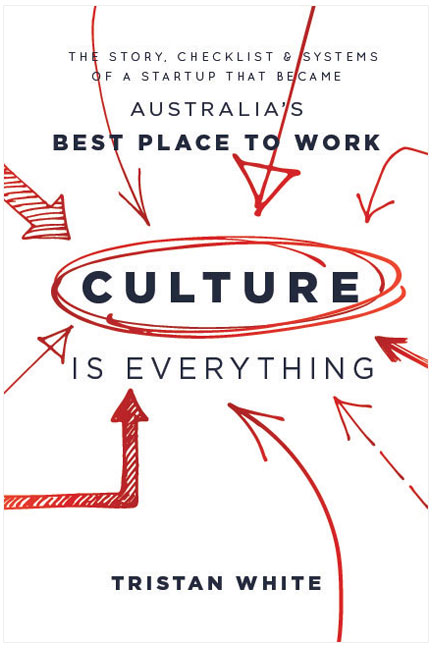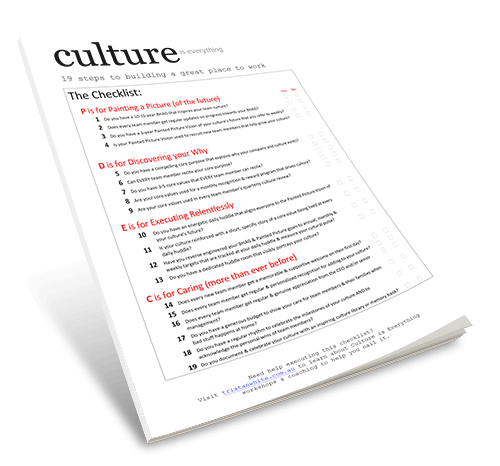
The Niggle I Couldn’t Ignore
When I released my book Culture Is Everything, I honestly thought I'd written everything I possibly could about building a strong, vibrant team culture.
It was my playbook. My love letter to the messy, challenging, and ultimately rewarding work of creating a people-first business. After years of building The Physio Co, testing and refining the Culture Is Everything System, I felt like I'd bottled the magic.
But then something unexpected happened.
As I hit the road delivering keynote after keynote, sometimes to rooms full of ambitious business owners, sometimes to corporate HR teams, or even the local chamber of commerce breakfast crowd, where the talk of the morning is usually cashflow headaches and keeping good people, not kombucha on tap. I kept feeling this niggle.
A little whisper in the back of my head: "Tristan… something's missing."
At first, I tried to ignore it. (Classic founder move: tell yourself you've already solved the problem and just need to shout louder.) But the more I shared the Culture Is Everything System, the clearer it became.
Solid systems, decent results
And here's the kicker: I was seeing it everywhere. Business owners with solid systems, great teams, decent results... but that spark was dimming. The Monday morning energy felt more like Monday morning obligation. Team huddles that used to buzz with genuine excitement now felt like everyone was performing enthusiasm.
The truth was this: without a deep, personal commitment to what I now call Personal Culture, even the strongest team culture risks going stale.
It's exactly like that fitness class you used to love, same instructor, same moves, same upbeat playlist, but now you're just going through the motions. The instructor's still enthusiastic, the music's still pumping, but somehow everyone's just... performing fitness instead of actually getting fit. The energy's there on the surface, but the real transformation has stopped happening.
Team culture without intentional Personal Culture becomes like a playlist stuck on repeat: catchy at first, but eventually, you're desperate for a new track.
And the worst part? As the leader, you start wondering if the problem is you.
Spoiler alert: it usually is. (Don't worry, I'll show you how that's actually good news.)
What This Really Costs You (And It's Not What You Think)
Here's what I've learned from talking to hundreds of business owners who've built "successful" cultures: the drift doesn't announce itself with a dramatic exit interview or a team revolt.
It's sneakier than that.
Your best people don’t leave; they just stop bringing their A-game. Meetings turn into box-ticking, innovation dries up, and what once felt natural now feels forced.

Like pushing a car with the handbrake on, you’re still moving forward, but everything takes twice the effort for half the result. And here’s the real kicker: you become the bottleneck, not because you want to, but because your team unconsciously mirrors your drift.
Thousand paper cuts
That hidden “drift tax” doesn’t hit all at once, it’s death by a thousand paper cuts. For a business with 15–50 people, it can quietly cost six figures a year in lost productivity, missed opportunities, and the energy required to constantly re-motivate a team that should be self-energizing.
But here's why this is actually good news...
The Missing Piece That Changes Everything
If the problem was your market, your competition, or some external force, you'd be stuck waiting for the world to change.
But when the problem is you? That's entirely fixable.
After years of uncomfortable self-reflection (and a few more facepalm moments than I care to admit), I discovered what was missing: Personal Culture.
Here's the simplest definition I can give:
Personal Culture is the way you lead yourself so you can keep showing up, connecting, and leading others.
What Personal Culture Isn't (Because Someone Always Asks)
Before we dive in, let me clear up a few things Personal Culture is not:
It's not about adopting some productivity guru's 4am ice bath routine. (Though if polar plunges are your thing, we can still be friends, from a safe, warm distance.)
It's not about becoming a different person or fixing some fundamental flaw in your character. You're not broken; you just might be running on autopilot.
It's not about achieving perfect work-life balance. (That mythical creature ranks somewhere between unicorns and employees who read the detail of every email.) It's about being intentional with the imbalance you choose.
And it's definitely not about adding more to your already overflowing plate. Personal Culture is about being more deliberate with what's already there.
Alive and humming
It's simply about becoming more intentional with the person you already are, the leader your team needs you to be, consistently, even when the coffee hasn't kicked in yet.
Think of your team culture as the house your team lives in. Personal Culture isn’t the foundation of the house, it’s the energy and steadiness that keeps the whole place alive and humming. Without it, even the strongest cultures eventually stall.
Your team’s culture will never have more energy than the fuel you bring as its leader.
Your team's energy is a mirror of your own. When you're coasting, they feel it. When you're growing, they're inspired to grow too. Personal Culture isn't selfish, it's the most generous thing you can do for your team.
Through years of trial and error (emphasis on error), and borrowing ideas from giants like James Clear, Stephen Covey, and even the ancient Stoics, I've refined Personal Culture into a three-part framework that actually works:
1. Lead Yourself First
2. Connect to Grow
3. Keep It Together
Simple? Yes. Easy? Well, that's like saying "just eat less and move more", technically correct, practically challenging.
Let me break down what each part actually looks like in practice:
1. Lead Yourself First (Or: How to Stop Being Your Own Worst Enemy)
Here's an uncomfortable truth: if the same problems keep showing up in your business, the common denominator is probably you.
I learned this the hard way when I realized I was complaining about team members not taking ownership while simultaneously micromanaging their every decision. (Turns out, helicopter leadership doesn't inspire independence.)
Leading yourself first means taking radical responsibility for your part in whatever's happening. Not blame, responsibility. Blame is about the past and makes you powerless. Responsibility is about choice and puts you back in the driver's seat.
It starts with getting crystal clear on what you actually stand for. Not what sounds good in a LinkedIn post, but what you're willing to make hard decisions about when nobody's watching. Your values aren't wall art; they're decision-making tools.
From there, it's about aligning your daily actions with your declared direction. The gap between what you say matters and what you actually do is where culture goes to die. Your team doesn't just hear your words, they watch your calendar, your priorities, and where you spend your energy.
Leadership isn't about being flawless; it's about being authentic enough to keep growing. When you're willing to evolve yourself, your team feels permission to grow too. That's when real culture starts.
2. Connect to Grow (Or: Why Trust Beats Strategy Every Time)
Business is a team sport, but too many leaders try to play it like chess, moving pieces around a board instead of building relationships with actual humans.
Here's what I've learned: progress happens at the speed of trust, and trust is built through genuine connection. That’s exactly what Brené Brown has been teaching leaders worldwide, that vulnerability and genuine connection are the real building blocks of trust.
People don't care how brilliant your strategy is if they don't feel seen, heard, and valued as more than a productivity unit.
Think about the café owner who knows every customer’s name and order, their team works harder because they feel part of something human, not just a roster. The same applies in your business.
Or picture the local tradie who keeps the same two apprentices year after year, not because he pays the most, but because he takes them for a Friday sausage roll, listens to their weekend stories, and actually remembers what they’re working toward. That connection beats any fancy HR policy.
This doesn't mean becoming everyone's best friend or turning every meeting into group therapy. It means investing in real relationships instead of transactional "how are you tracking against your KPIs?" check-ins.
When your team trusts you, they'll listen when you challenge them, stretch for bigger goals, and support each other through the inevitable tough patches. Without trust, even the simplest initiatives feel like you're pushing water uphill with a fork. (And trust me, I’ve tried, forks are terrible shovels.)
The mechanics are simpler than you think: clear expectations, honest feedback, and consistent rhythms of actually talking and listening. Not glamorous, but it's the oxygen that keeps your culture breathing.
And here's the part that trips up a lot of well-meaning leaders: connection isn't about being soft. It's about balancing empathy with accountability. Care enough to understand people's challenges, but respect them enough to hold the line on standards. That's leadership.
3. Keep It Together (Or: How to Avoid Becoming a Cautionary Tale)
The best cultures don't collapse because of weak strategy or bad market conditions. They crumble because the leader burns out and affects everyone around them.
Leadership is an infinite game, and you can't carry others if you can't carry yourself. This pillar is about building the support structures and rhythms that keep you steady when everything else feels chaotic.
First: find your pit crew. Mentors, peers, advisors, people who'll remind you that you're not alone in this race and that every successful leader has moments of doubt. Business ownership is inherently lonely; don't try to white-knuckle it in isolation.

Second: build reflection into your rhythm. Without regular pauses to assess what's working and what isn't, you drift. With it, you adapt and improve. Even something as simple as a weekly review can keep you on track instead of reactive.
And yes, this means looking after your physical body too. Sleep, movement, decent fuel. Not because you're training for a marathon, but because a strong body supports a strong mind. Your team doesn't need you to be superhuman; they need you to be consistently present and engaged - preferably without the glazed ‘I slept three hours and lived on coffee and M&Ms’ look.
When you keep it together, you give your team something invaluable: stability. They don't just hear your words; they feel your steadiness in action. That's what earns trust over the long haul.
How This Links Back to Everything You've Already Built
If you've read Culture Is Everything or implemented any team culture systems, I want to be crystal clear: none of that work was wasted.
The team rituals, the values work, the huddles, the celebration systems, they're all still crucial. Personal Culture doesn't replace them; it powers them.
Think of it this way: team culture is the engine of your business. Personal Culture is the fuel that keeps the engine running smoothly year after year, instead of sputtering out after the initial excitement wears off.
When you nail Personal Culture, firstly for yourself, then teach those practices to your team, something magical happens to your existing team culture initiatives:
- Those Monday huddles stop feeling like performance art and start generating real energy again
- Your team values become living decision-making tools instead of wall decorations
- Feedback conversations become genuine development opportunities instead of awkward obligation boxes to tick
- Your culture adapts and evolves instead of going stale
Your team's culture will never be stronger than your personal commitment to growth. But when you get both working together? That's when you build something that doesn't just survive the ups and downs of business, it thrives through them.
Your Next Steps (Because Reading Without Action Is Just Expensive Entertainment)
If you're ready to unlock your Personal Culture and re-energize everything you've already built, here's my challenge:
Don't try to overhaul everything at once. (That's how good intentions go to die alongside gym memberships and abandoned diets.) Start with one thing. This isn’t a trip to Bunnings on a Saturday morning, you don’t need to come home with six new projects you never planned for.
Instead, pick one element from each pillar and commit to it for the next 30 days:
From Lead Yourself First: Define one personal core value that will guide your next three major decisions. Write it down. Use it.
From Connect to Grow: Schedule one genuine conversation with a team member you've been meaning to connect with. Not about KPIs or project updates, about them as a person and their aspirations.
From Keep It Together: Establish one non-negotiable weekly ritual that keeps you grounded. Maybe it's a 20-minute Friday reflection, maybe it's actually leaving the office before your family forgets what you look like.
That's it. Three small commitments that will start shifting everything.
Here’s the truth: your business culture isn't something that happens to you. It's something you create through the thousands of small choices you make every day.
Personal Culture is simply being more intentional about those choices.
Here’s to Personal Culture Unlocked, because when you grow, your team thrives.
___
NB - Personal Culture isn’t the whole story. It’s one of three essentials: Team Culture, Personal Culture, and Money Culture. Together, they form The Culture Effect Platform, a complete way to build businesses that thrive long after the founder’s energy alone could carry them.



